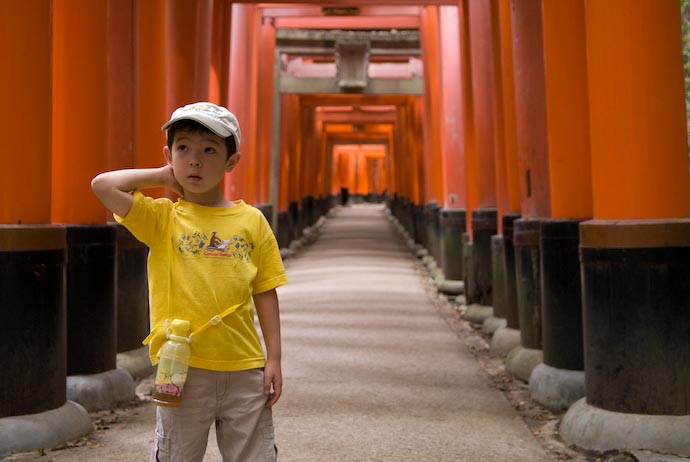
Nikon D200 + Nikkor 17-55mm f/2.8 @ 32 mm — 1/50 sec, f/2.8, ISO 500 — map & image data — nearby photos
Marveling at Innumerable Shrine Gates
Fushimi Inari Shrine, Kyoto Japan
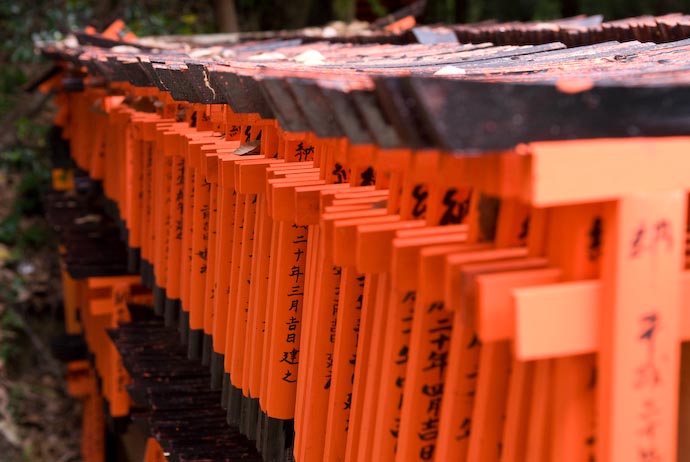
Nikon D200 + Nikkor 17-55mm f/2.8 @ 40 mm — 1/80 sec, f/4.5, ISO 400 — map & image data — nearby photos
Hundreds of Miniature “Shrine Gate” Offerings
Fushimi Inari Shrine, Kyoto Japan
Wow.
Wow wow wow.
I've lived in this part of the world for the better half of the last 20 years, but today was my first visit to the Fushimi Inari Shrine (伏見稲荷大社) in south-east Kyoto, and it was amazing.
I'd heard enough about it to know that it had a path lined with a bunch of torii gates, but I was totally unprepared for the thousands and thousands of gates lining miles of mountain paths.
And frankly, that wasn't even the best part, but it was such a visually-overwhelming experience for someone with an eye toward photography that I don't even know where to begin. So, I'll just start at the start.
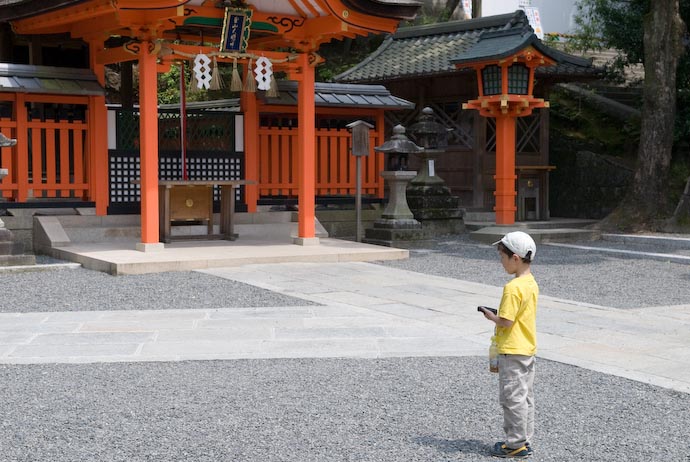
Nikon D200 + Nikkor 17-55mm f/2.8 @ 38 mm — 1/800 sec, f/6.3, ISO 200 — map & image data — nearby photos
GPS Unit in Hand
The treasure hunt begins
I'd found out about a geocache at this shrine, and thought it would be a fun thing to try to find it with Anthony. A geocache is a treasure that someone's planted somewhere such that you're not likely to find it unless you look, and they publish its latitude and longitude to a site like geocaching.com. I knew that it would be a photogenic trip, but I also knew that he wouldn't care about that, so adding a “treasure hunt” aspect made it interesting for him as well.
So, we scootered the three miles south from our place, and arrived to find a shrine complex that was typical in general appearance, but atypical in grandeur – it was huge – and was clearly well funded. It's the head shrine dedicated to industry and worldly success, after all.
There were many buildings, and a few large gates, but not the gate-lined paths I'd seen in pictures, so we headed back behind the main complex, and soon spotted some gates through the trees....
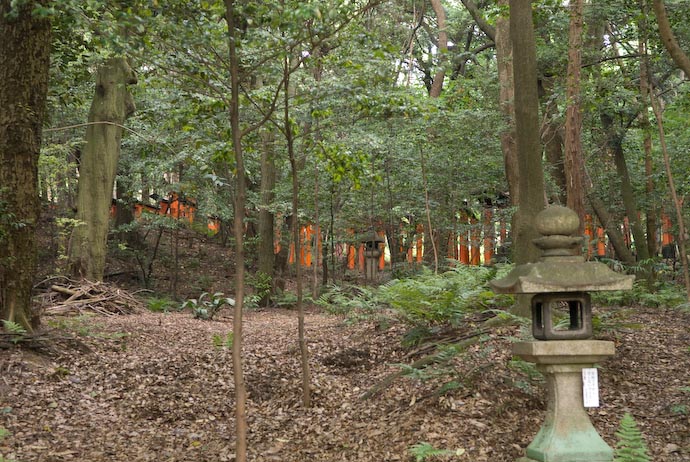
Nikon D200 + Nikkor 17-55mm f/2.8 @ 45 mm — 1/25 sec, f/3.5, ISO 400 — map & image data — nearby photos
First Sighting
It doesn't come out in the picture very well, but it was almost breathtaking to see them in the distance like that, through the trees. We never did get onto that specific path, but soon came upon the start of the gates on the path we were on...
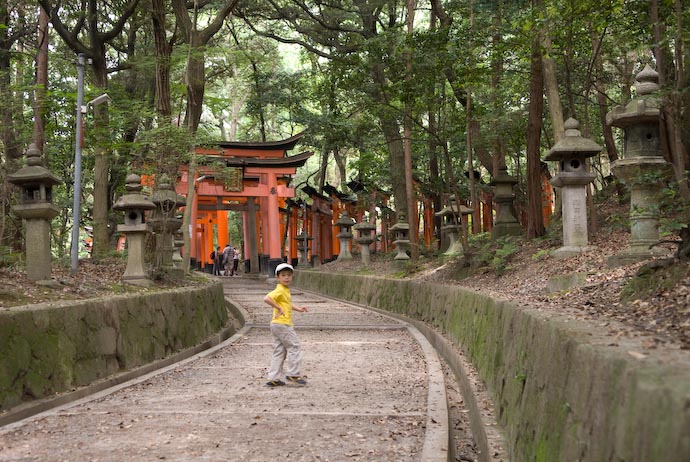
Nikon D200 + Nikkor 17-55mm f/2.8 @ 30 mm — 1/40 sec, f/3.2, ISO 400 — map & image data — nearby photos
“Hey, Look, It's Amazing”
The gates are generally made of wood, although the occasional stone gate can be spotted from time to time. Each has been donated by a person or a company (at an expense that likely starts in the $10,000 - $20,000 range), and each is unique. There's a wide variety of shapes, colors, sizes, and ages, all mixed together. Many are new or sport a fresh coat of paint, but just as many are rotting and crumbling back to nature.
Each is engraved with “donation/offering” across the top, and the name of the donor on one leg, and often, the date it was erected engraved on the other...
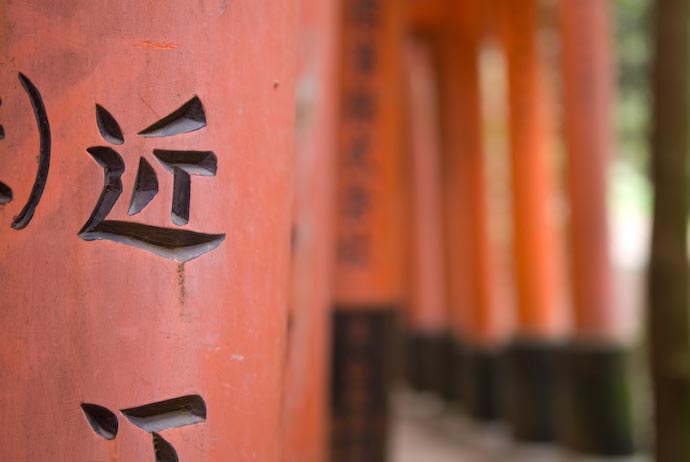
Nikon D200 + Nikkor 17-55mm f/2.8 @ 40 mm — 1/30 sec, f/2.8, ISO 400 — map & image data — nearby photos
Engraved and Painted
but dirty and fading
The writing is generally only on one side, which is why you don't see any in the first picture at the top of this post.
This shrine has been around for over 1,000 years, but its collection of gates is constantly changing such that it might almost seem alive. There were plenty of sections of path that had no gates at all, but you could see from the patterns on the ground that the path had been fully packed with gates at some time in the past.
The paths are fairly well covered by the forest canopy, and it was an overcast day to begin with, so both helped keep us from getting too hot while climbing, but at the same time, they conspired to rob me of enough light to make sharp photos.
You can see one stone gate in the picture below, with writing down its leg saying “erected on an auspicious day in July, 1921” (in the 10th year of the reign of the Taisho emperor). In the background, one of the gates is being painted.
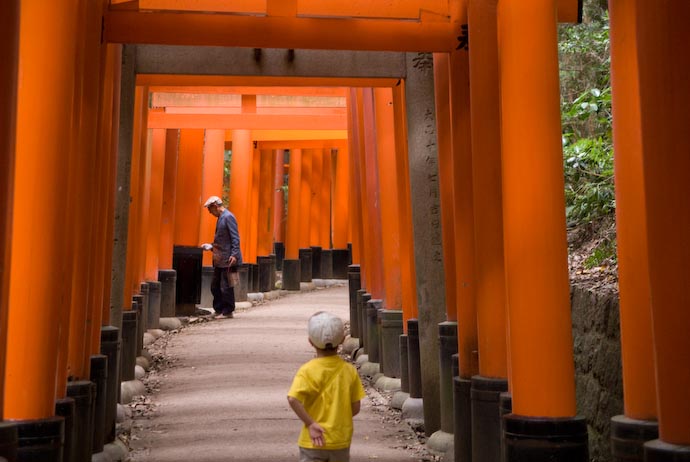
Nikon D200 + Nikkor 17-55mm f/2.8 @ 55 mm — 1/50 sec, f/2.8, ISO 640 — map & image data — nearby photos
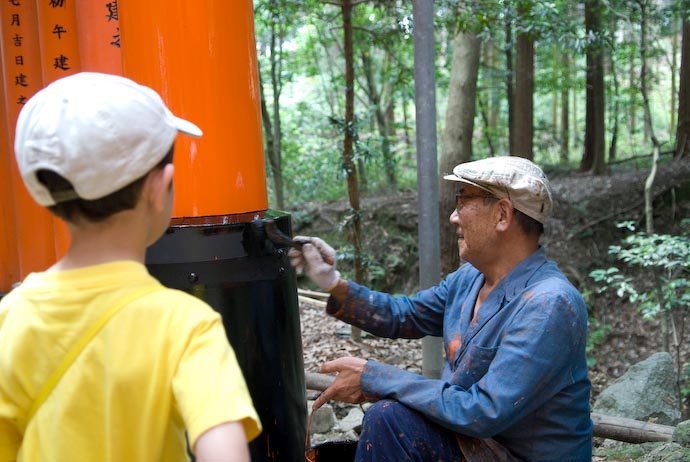
Nikon D200 + Nikkor 17-55mm f/2.8 @ 24 mm — 1/40 sec, f/2.8, ISO 640 — map & image data — nearby photos
Finishing Touches
We chatted with the painter a bit. He'd been hired by the donor to paint the gate, and I took it from his black-and-orange-speckled attire that gate maintenance was what he did for a living. The gate he was working on was originally placed there seven years ago, but had rotted so much in that time that it had to be replaced, so he was painting the replacement. He said that, generally speaking, they should be repainted every four to five years.
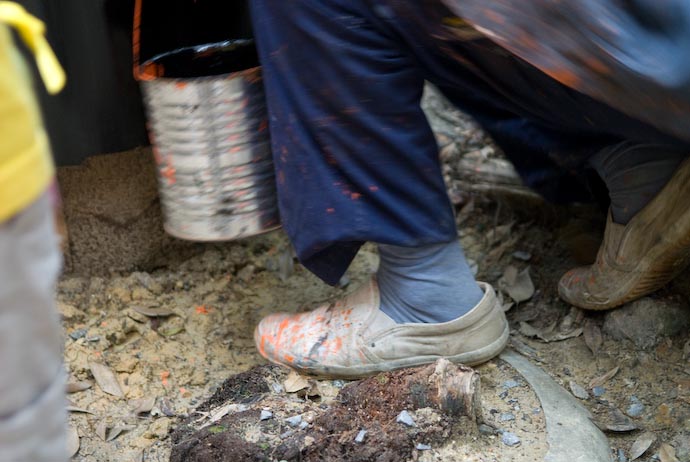
Nikon D200 + Nikkor 17-55mm f/2.8 @ 55 mm — 1/20 sec, f/2.8, ISO 640 — map & image data — nearby photos
There were plenty of gates that were less than 10 years old but rotting out, and equally plenty that were older than 30 years and still looked just a fresh coat of paint shy of new. It seemed that most, though, were less than 20 years old, and in good condition.
Considering that I first came to Japan 20 years ago, I found it amazing to realize that had I visited here then, most of the gates I would have seen then would now be gone, having been (I presume) abandoned by their donors, and replaced with new donations. There are thousands and thousands of gates, so I imagine that a 20-year timelapse video would look very busy indeed.
Unlike the well-ordered, clean lines of the large shrine complex at the foot of the mountain, these gate-covered paths meandered all over the place, and were dotted by all manner of sub-shrine crammed into nooks and crannies of the mountain.
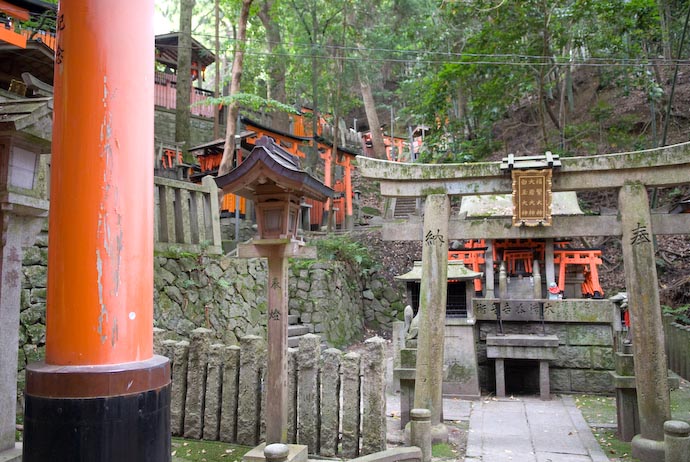
Nikon D200 + Nikkor 17-55mm f/2.8 @ 19 mm — 1/45 sec, f/2.8, ISO 640 — map & image data — nearby photos
Plenty of Sub-Shrines Along the Way
It is perhaps difficult to see in the small version of the photo above (click on photos for larger versions), but in this picture I took looking out to the side from the main path, you can see layer after layer of sub-shrines receding into the distance.
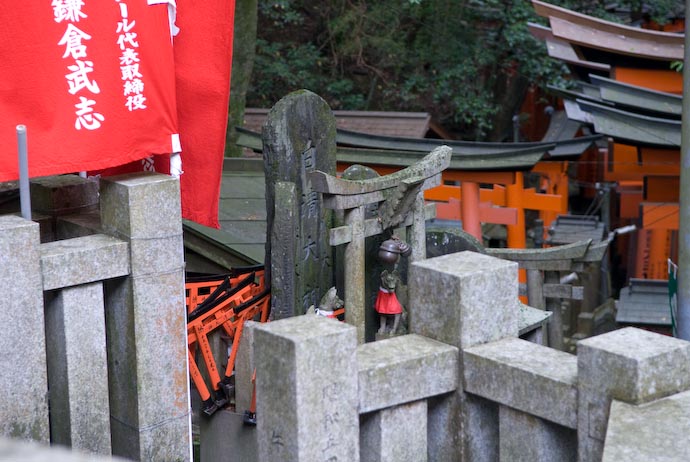
Nikon D200 + Nikkor 17-55mm f/2.8 @ 55 mm — 1/60 sec, f/4, ISO 500 — map & image data — nearby photos
Visual Cacophony
Due, I'm sure, both to the mountainous nature and long history of the location, everything seems to be laid out quite haphazardly. It's really a visual smorgasbord for anyone pausing to really look, and my mind almost exploded thinking of the photographic possibilities. Although my imagination seemed unlimited, in practice, I was limited by a lack of skill, the aforementioned lack of light, a lack of equipment (I had only two lenses with me), and most limiting, a five year old not interested in dallying for photos.
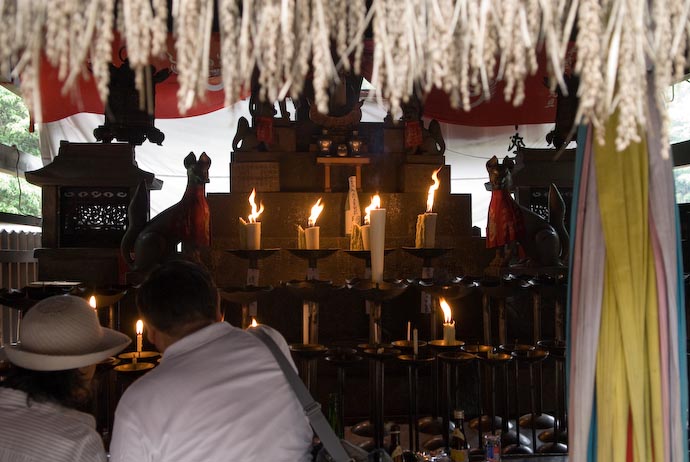
Nikon D200 + Nikkor 17-55mm f/2.8 @ 26 mm — 1/30 sec, f/3.5, ISO 400 — map & image data — nearby photos
Elaborate Sub Shrine
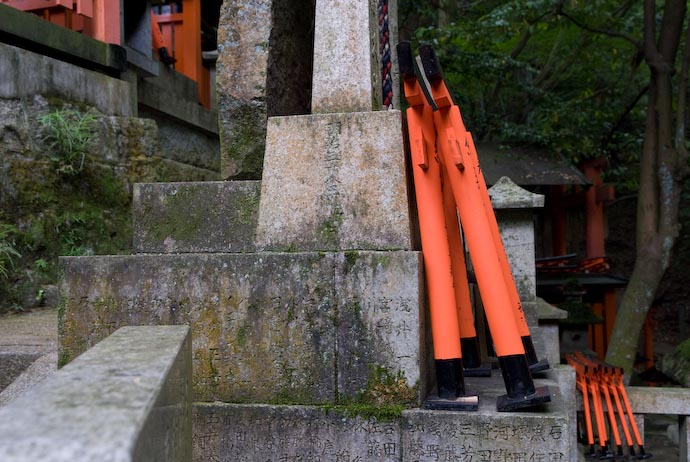
Nikon D200 + Nikkor 17-55mm f/2.8 @ 26 mm — 1/90 sec, f/5, ISO 500 — map & image data — nearby photos
Old and New
Small wooden replica gates — from a few inches high up to a couple feet high – were piled and stacked all over the place. I wouldn't be surprised if there were 100,000 of them scattered about. The larger ones cost a donation of $100, and all that I noticed were dated within the past few months, so there must be a small army of people making/painting/selling these things.
The two above are leaning against a stone dated 1905 (year 38 of the reign of the Meiji emperor).
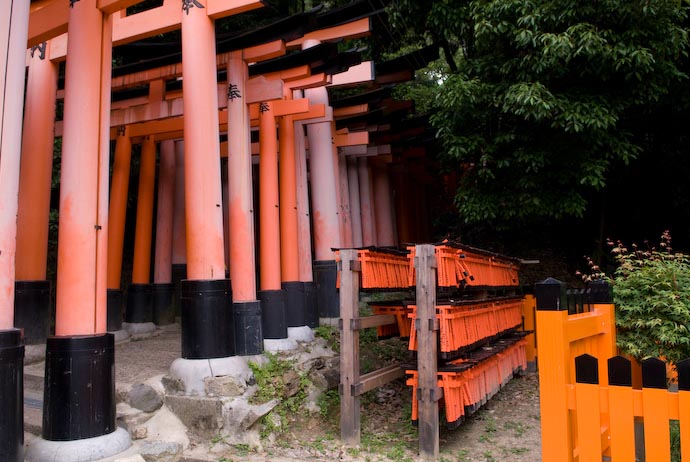
Nikon D200 + Nikkor 17-55mm f/2.8 @ 17 mm — 1/320 sec, f/4.5, ISO 400 — map & image data — nearby photos
Racks of Mini Gates
along side a main path
Pretty much every shade of color that could be considered “orange” was to be found. Above, you can see racks of recently-painted bright orange mini-donation gates sandwiched between the faded orange of the real gates, and the almost-plastic brilliant (but different shade) orange of the fence. The difference is likely diminished on common computer monitors (these pictures look anemic on my laptop screen, for example), but on my high-end Eizo monitor the colors jump off the screen to almost sear the retina.
The rack of mini gates isn't all that old.... you can see in the 2nd picture on this post dates from March and April... but weather was already taking its toll....
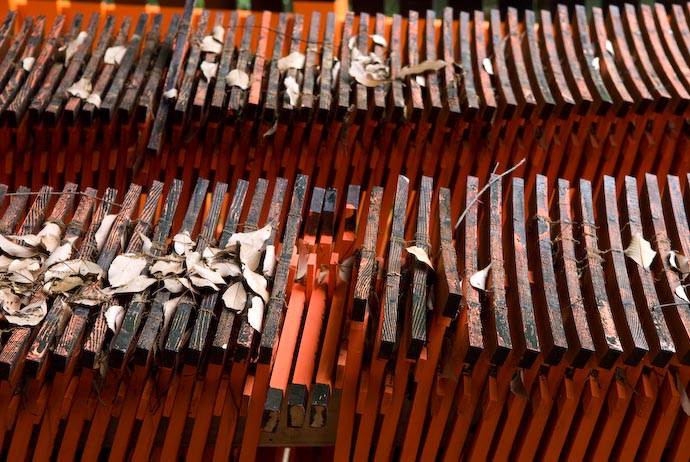
Nikon D200 + Nikkor 17-55mm f/2.8 @ 48 mm — 1/60 sec, f/5, ISO 400 — full exif & map — nearby photos
Disturbed
The path from the base of the mountain to where these last few pictures were taken was fairly gentle, but ended with one long, steep section of stairs up to this picturesque location that overlooks a lake.
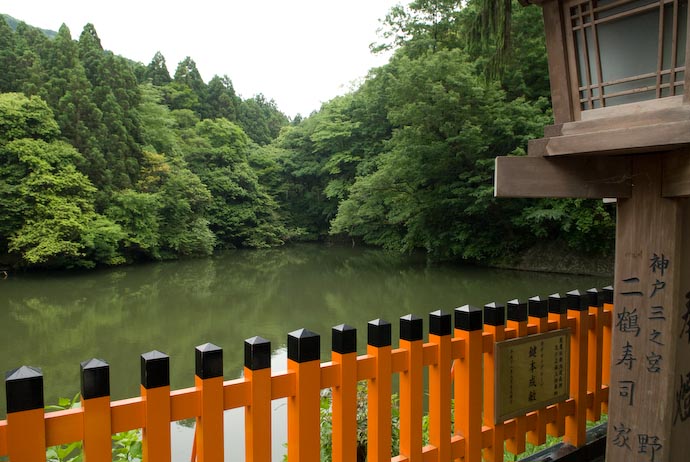
Nikon D200 + Nikkor 17-55mm f/2.8 @ 17 mm — 1/350 sec, f/5, ISO 500 — map & image data — nearby photos
Pretty Lake
beyond a brightly-colored (donated, of course) fence
The path continues up the mountain, but I got the impression that a lot of people turn around and head back at this spot. That's a shame, because the best was yet to come.
Can’t wait to hear how the geocaching went with Anthony. The location is certainly worthy of a geocache!
Chris
Did you try to eat “sparrow”? “Fusimi-inari” is also famous for sparrow which is skewered and grilled.(really!) I’ve not visited there yet , and I want to go.
What a gorgeous place. When I consider that we were in Kyoto and chose to visit some of the other sites instead of here, I want to kick myself. Your photos are terrific. Thanks for posting.
This shrine has been high on my list for awhile, last time I was in Kyoto I was set to go but was hung up with a bad cold… Your photos are great for getting some different perspectives on the place, but I know there is nothing like being there in person…
Hi Jeffrey,
You got some really nice images on this trip. There are several in this post that I think are wonderful photos all around, even without the entertaining story.
My wife’s family has gravesites all over kyoto, but the main one is at the very top of Fushimi Inari, conveniently near the little resthouse/snackshop there.
Funny thing, two of the times I went up there, the Kuroneko man was also going up with supplies for that rest house. He puts on a big backpack to hold the packages, and then he jogs all the way up like everyone else. I would assume he drops off the packages down below, but no, it’s a full-service company. All the way to the top. Unbelievable.
This is must visit place when we are come to Kyoto. I saw pictures of this place in somewhere else but these just comfirmed our visit to Fushimi Inari. Thanks for really nice pictures. I guess we have to reserve one day for exploring this place and to take few good photoes.